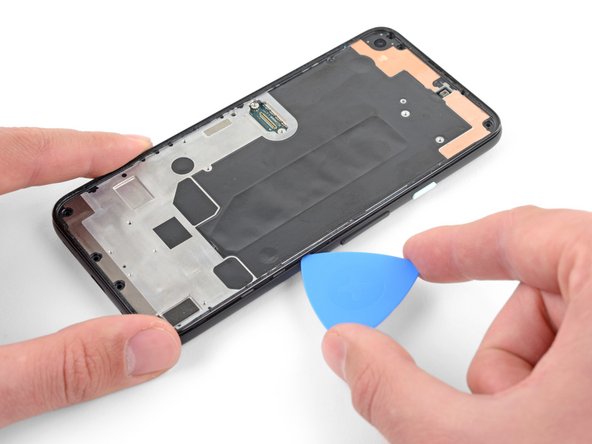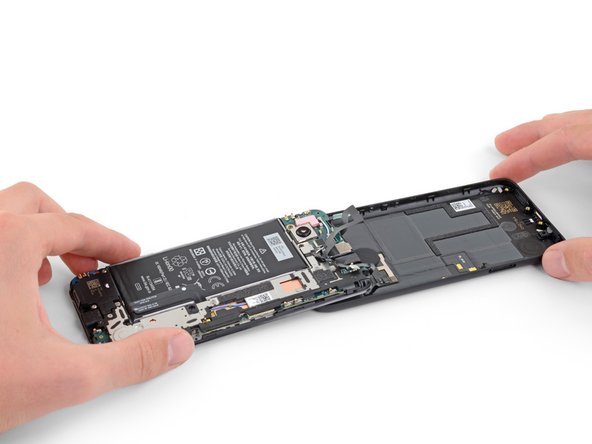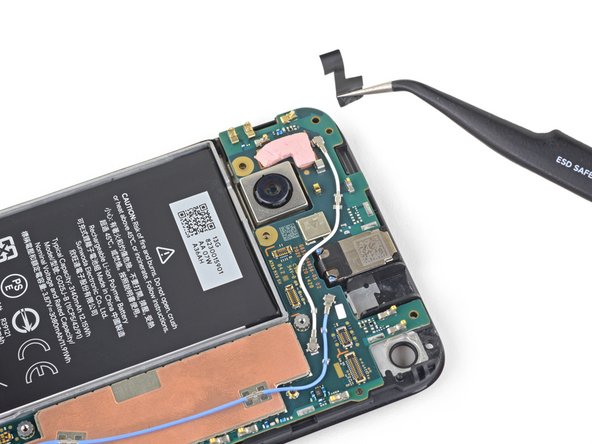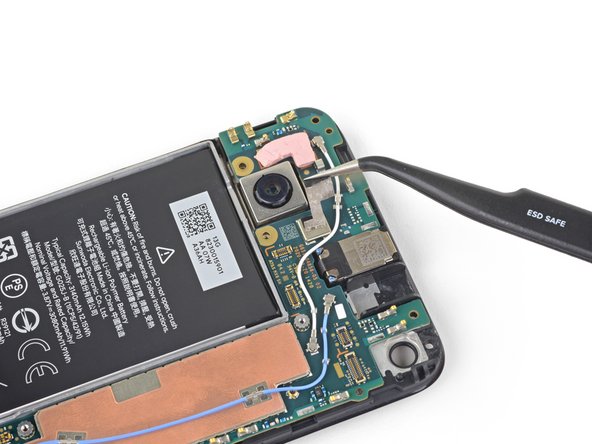How to Replace Google Pixel 4a Motherboard: Step-by-Step Guide
Duration: 45 minutes
Steps: 41 Steps
A heads up from the team at Salvation Repair: this guide is created in-house and not officially endorsed by Google. Want to know more about our approach to repair guides? Learn more here.
Be gentle with the Pixel 4a’s display panel – it’s a bit fragile and doesn’t have any extra reinforcement. If you need help, you can always schedule a repair
The team at Salvation Repair put together this guide to help you replace the motherboard on your Google Pixel 4a. Be careful when handling the display panel – it’s pretty fragile. If you’re planning to reuse the screen, make sure to check out the warnings in the opening steps. Ready to get started? Follow these steps for a smooth repair. If you need help, you can always schedule a repair.
Step 1
– Grab your trusty SIM eject tool, a handy bit, or a straightened paper clip—whatever works for you! Now, gently insert it into the SIM tray hole.
– Give it a little press right into that hole to pop out the SIM card tray.
– Now, go ahead and pull out the SIM card tray with a little finesse.
Step 2
Heads up! There’s a little orange ribbon cable hiding under the screen’s bottom right corner. It’s super sensitive, so be careful not to jam your tool into it. Just a tiny bit of wiggle room is all you need to separate that sticky screen.
You gotta lift the screen to detach it from the phone. Make sure to read the notes below before diving in.
– Let’s get started by checking out the two seams on the edge of your phone:
– Before you dive in, take a look at these important areas on the screen:
– Screen seam: This is the line that separates the screen from the rest of the phone. It’s where you’ll want to carefully pry open your device.
– Frame seam: This is where the plastic frame meets the back cover, held together with screws. Be careful not to pry at this seam, or you might damage something.
– Screen flex cable: When you’re using your opening pick, make sure not to insert it too far, or you might damage this important cable.
– Adhesive perimeter: When prying, stay within this narrow area and angle your pick to avoid damaging the OLED panel. If you need help, you can always schedule a repair
Step 3
When using heat to loosen things up, remember that a hair dryer, heat gun, or hot plate can be your best friend – just be gentle and avoid overheating, as your phone’s display and internal battery are sensitive to high temperatures. If you need help, you can always schedule a repair
– Time to get this repair started! Apply a heated iOpener to the right edge of the display for about a minute. This will help loosen the adhesive, making the next steps a breeze. If you need help, you can always schedule a repair
Tools Used
Step 4
If your screen is in rough shape with cracks galore, slapping on a layer of clear packing tape might just give that suction cup a fighting chance to stick around. Not a fan of packing tape? No problem! You can try using some super strong tape instead. And if you’re really in a pinch, a little superglue on the suction cup could do the trick to hold it to the cracked display. Remember, when in doubt, if you need help, you can always schedule a repair.
– Get started by placing a suction cup super close to the right edge of the screen – you’re doing great already!
– Now, gently lift the suction cup with a steady force – you’ve got this!
– Next, carefully insert the tip of an opening pick into the screen seam, about 1 mm in – nice and easy! If you need help, you can always schedule a repair
Step 5
Hold up there! If you notice the pick hitting a bump, it’s probably pressing against the edge of the OLED panel. Just tilt the pick a bit and give it another go!
This step will guide you on how to carefully insert the pick without causing any harm to the OLED panel. Make sure to do this before you start slicing through the adhesive.
– Get your pick in the game – slide it 1 mm into the gap, then pivot it upwards to a nice steep angle. You got this!
– Now that you’re at a steep angle, gently push the pick into the gap about 1/4 inch (6 mm). It should slip in smoothly below the OLED panel. If you need help, you can always schedule a repair
Step 6
Be careful not to insert the pick more than 1/4 inch (6 mm) into your device, or you might accidentally damage the screen’s flex cable. If you need help, you can always schedule a repair
– Now it’s time to get that adhesive loose – gently slide the pick along the right edge of the screen to break it down.
– Leave the pick hanging out in the top right corner, like a trusty sidekick, to keep that adhesive from sneaking back into place. If you need help, you can always schedule a repair
Step 7
Be careful as you work around that delicate cable hiding out under the bottom-right corner of the screen! If your opening pick gets stuck on something, just pull it out and give it another go. Remember to keep your pick angled downward and only go in as deep as necessary to break that adhesive—no more than 2 mm deep, please! You’ve got this!
– Let’s get this phone open! Gently insert another opening pick into the right edge of the phone at an angle where a gap has already formed. This will help prevent any scratches on that fancy OLED panel.
– Now, slide that pick around the bottom of the phone to cut the adhesive. We’re basically giving that adhesive a little massage.
– Leave the pick inserted along the bottom edge to keep that adhesive from sealing itself back up. We want to make sure we can get that phone open!
Step 8
If the screen is being stubborn, try heating the left edge for about a minute and then give it another shot. If you need help, you can always schedule a repair
– Slide another opening pick into the bottom edge of your phone at a fun angle where a gap has already popped up—this will keep your OLED panel safe and sound.
– Use that pick to glide along the left edge of the phone like a pro.
– Keep the pick in place along the left edge to stop the adhesive from getting all clingy again.
Step 9
Time to get cozy with your device’s insides! Check out the earpiece speaker’s mesh cover on the top screen edge. If you’re missing a replacement, take extra care not to lose or damage this guy.
– Now it’s time to add another opening pick to the left edge of your phone – just slide it in at an angle where you’ve already got a gap going, and you’ll be protecting that OLED panel in no time.
– Next, take your pick and gently slide it around the top edge of your phone to cut through the adhesive. If you need help, you can always schedule a repair
Step 10
Hold off on removing the screen for now. Let’s take it one step at a time to ensure everything goes smoothly. If you need help, you can always schedule a repair
– After you’ve trimmed the edges of the phone, gently lift the right side of the screen, just like you’re flipping open a book to reveal an exciting story.
– Grab an opening pick and carefully slice through any stubborn adhesive that’s still hanging on.
Step 11
Hey, be gentle with that ribbon cable! It’s delicate like a butterfly’s wing, so try not to put too much pressure on it.
Step 13
Hey there! Don’t get lost in the screw-tastic world of your device. Make sure each screw goes back in its rightful place! You’ve got this! 😉
– Let’s get started! Use a T3 Torx driver to remove the two 2.1 mm screws that hold the screen connector bracket in place. If you need help, you can always schedule a repair
Step 15
– Grab your trusty spudger and gently pry up to disconnect that pesky screen flex cable. You got this!
– When it’s time to reconnect, just align those connectors like a pro. Press down gently on one side until you hear that satisfying click, and then do the same on the other side. Remember, no pressing in the middle! If things get misaligned, those pins can bend and we don’t want that. Keep it smooth and easy!
Tools Used
Step 16
When you boot up your device after reassembling it, the screen will run through a quick calibration process. Just let it do its thing – don’t touch the screen until it’s finished, or you might end up with some wonky touch settings. If you need help, you can always schedule a repair
Check out the third photo to help you get your adhesive stickers in just the right spot!
– Kick off by gently taking off the screen.
– Ready to rock a new screen? Here’s how:
– First, check if your replacement screen comes with the speaker mesh and top edge adhesive already in place.
– If you’re feeling crafty, follow this guide to put on that custom-cut adhesive like a pro.
– If it does, high five! You can skip the top edge adhesive.
– If it doesn’t, peel off the larger clear liner from the top edge adhesive and stick it onto the screen (not the frame). Make sure that larger cutout aligns perfectly with the speaker mesh.
Step 17
– Grab your trusty T3 Torx driver and get ready to tackle those eight 4.3 mm screws that are holding the back cover snugly in place. You’ve got this!
Step 18
– Let’s get this party started! Grab your trusty opening pick and slide it into the gap between the midframe and the back cover. It’s like slipping into a comfy pair of shoes, but for your phone!
– Now, gently glide the opening pick along the bottom edge of your phone. This will release the plastic clips holding the back cover to the midframe. Think of it as giving those clips a little high-five to say ‘thanks for your service!’
Step 19
– Gently glide the opening pick along the left edge of your phone to pop those plastic clips free, letting the back cover detach from the midframe like a pro!
Step 20
– Alright, let’s get this party started! Slide the opening pick around the top and right edges of the phone to release the rest of the clips. Don’t be shy, give it a little wiggle! If you need help, you can always schedule a repair.
Step 21
– Gently swing the back cover from the bottom of the phone over the top and around the back like a pro!
– Place the back cover on your work surface and carefully rest the midframe on it, making sure those delicate ribbon cables are treated with the utmost care.
Step 22
– Let’s get this motherboard bracket off! Use your T3 Torx driver to remove those seven screws holding it in place. Three of them are the shorter 2.9 mm black screws, and three more are the 2 mm kind. The final screw is a bit longer at 4.1 mm. Easy peasy, right?
Step 23
– Gently slide the tip of your spudger into the upper-right and lower-right corners of the motherboard to pop off the bracket. You’ve got this!
Tools Used
Step 24
– Grab those tweezers and gently remove the motherboard bracket. It’s like a tiny dance for your tech!
Tools Used
Step 25
– Time to get started! Use the flat end of a spudger to carefully pry up and disconnect the battery cable. If you need help, you can always schedule a repair
Tools Used
Step 26
– Now, grab your spudger and gently pry up the two flex cables connecting the fingerprint sensor and buttons to the motherboard. Think of it like giving those cables a little high-five! No need to be rough though, just a gentle nudge will do the trick. If you need help, you can always schedule a repair.
Tools Used
Step 28
– Time to get fancy with the headphone jack! Using the tip of a spudger, gently disconnect the headphone jack cable from the motherboard. Take your time and be careful – we want to make sure we don’t hurt any delicate parts. If you’re feeling a little unsure, you can always schedule a repair with us.
Tools Used
Step 29
– Slide an opening pick beneath the headphone jack and give it a twist to pop it free from the adhesive holding it to the midframe.
– Go ahead and lift out the headphone jack.
Step 30
– Gently pry up using the flat end of a spudger to detach the front-facing camera from the motherboard. You’ve got this!
Tools Used
Step 31
– Time to get up close and personal with your device’s front-facing camera! Use a trusty pair of tweezers to carefully remove it. If you need help, you can always schedule a repair
Tools Used
Step 32
– Grab your trusty T3 Torx driver and let’s get those two 4.1 mm screws out of the loudspeaker assembly. You’ve got this!
Step 33
Just a friendly reminder: watch out for that delicate white membrane on both sides of the speaker! If you want to keep it intact for reuse, give it some extra love and care.
– Time to get started! Carefully slide the tip of a spudger under the loudspeaker assembly to loosen it.
– Now, gently flip the loudspeaker assembly over so it rests nicely on top of the battery. If you need help, you can always schedule a repair
Tools Used
Step 34
– Use the tip of a spudger to gently disconnect the antenna flex cable from the loudspeaker assembly. It’s like a tiny dance, just be careful not to tug too hard!
Tools Used
Step 35
Be gentle with that white membrane on either side of the speaker, or you might end up having to replace it – and we want to help you avoid that extra step! If you need help, you can always schedule a repair
– Gently lift the loudspeaker assembly away from the tape holding it down. You’ve got this!
– Now, go ahead and take out the loudspeaker assembly. Easy peasy!
Step 36
– Now, let’s give that loudspeaker cable a little nudge! Use the tip of your spudger to gently disconnect it from the motherboard. Don’t worry, it’s a simple disconnection. If you need a little extra help, you can always schedule a repair.
Tools Used
Step 37
– Grab your trusty T3 Torx driver and give those three screws securing the motherboard a little spin! You’ll find two 2.9 mm long black screws and one 2.1 mm long screw. Don’t worry, it’s a piece of cake. If you need help, you can always schedule a repair
Step 38
– Now it’s time to carefully pry up the tape covering the earpiece speaker – use the corner of an opening pick to get the job done.
Step 39
– Grab your trusty tweezers and carefully remove the tape that’s covering the earpiece speaker – it’s time to set it free!
– Don’t worry about putting this tape back on when you’re reassembling, it’s not necessary. If you need help or get stuck, you can always schedule a repair
Tools Used
Step 40
– Gently slide the spudger’s tip under the bottom edge of the motherboard and give it a little lift to help you grab it with your fingers!
Tools Used
Step 41
– Let’s get started by carefully removing the motherboard from your device. This is a crucial step, so take your time and make sure you’re handling the components with care. If you need help, you can always schedule a repair




































































































